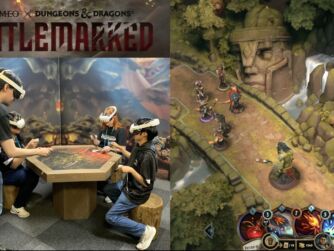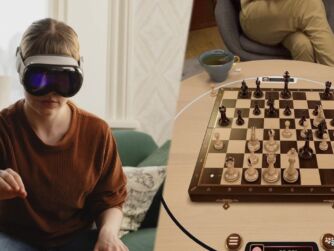I catch up with Dirk Reiners at IEEE VR to talk about Information Visualization, VR Industry Pioneers, & Mutli-Projection CAVES.
Become a Patron! Support The Voices of VR Podcast Patreon
Theme music: “Fatality” by Tigoolio
Subscribe to the Voices of VR podcast.
Rough Transcript
[00:00:05.412] Kent Bye: The Voices of VR Podcast.
[00:00:11.972] Dirk Reiners: My name is Dirk Reiners, I'm an Associate Professor for Information Sciences at the University of Arkansas, Little Rock. And coming into VR, wow, that throws me back about 25 years today. So really, I came into VR through sort of the game scene. Now that we're coming back to games, I feel like I'm going home. So I always wanted to have immersive games. Really, I did a talk about this a few months ago and I thought about it and really what brought me into it was this dream of being in Star Wars Episode V and flying my ice flyer through the legs of an AT-AT. So that's really what I wanted to do. Of course on Atari 8-bit machines in the 1980s that was a little difficult. That didn't quite work out the way I expected. But then when I finished my undergrad, I got into VR with the people that could do it in the 90s. That was people that had enough money for a million dollar Silicon Graphics machines. And this was in Germany, so that meant cars. Car companies had money for that. So I joined the Fraunhofer Institute for Computer Graphics in Darmstadt and we did a lot of work on the early VR work for the German car companies. Which was very interesting. It was a very interesting environment. People that didn't really know what the technology could do, which at the time was not that much. Nowadays we throw around models with millions of polygons like it's nothing. When we started we had to reduce a whole car to 50,000 polygons to stay within the 30 to 60 hertz frame rate that we were targeting. So there were some interesting challenges in making things work and it was interesting to do. Really the fascination was the immersion. We built some of the first caves in the world, in Germany, five-sided caves. How do we make these things work? That was really the thing that drove me and my research. and trying to figure out how can we build software systems that help people that know graphics, that know what they want to do, but are not experts in VR. How can we make software systems that helps them write applications? And that's really what drove me for a long time. So in 94, I did my master's thesis on a virtual reality rendering system. Then we moved on, tried to use some other people's, and then I don't know who was around in the late 90s when all the scene graphs collapsed when Performa went away and Microsoft's Fahrenheit went away. So then we decided to do our own. So we did an open source scene graph called OpenSG in the early 2000s and we got some pretty good success. We did a lot of stuff driving clusters. Because at that time, if you wanted to do something high res, which really makes a huge difference, many people don't really value the resolution that you can get and the benefit that you can get from more resolution. because they're used to their 1280x1024 monitor, and nowadays maybe a 1600x1200 monitor, but we've had those. In the early 90s, things haven't changed that much, so getting higher resolution meant doing clusters, and we did that fairly successfully. We built 48 PC, 48 projector, stereo projection, and that was an interesting experience. We call it the high wall, because about 10 feet distance from the wall, you had the resolution of the eye. You couldn't get any higher than that. It's an interesting experience to interact with the wall by just walking. You can walk closer and you see more detail. It's something that you really don't get in other ways. So that was interesting. Did a lot of that and then we had to fight a lot of problems, challenges in terms of technology. So that's what we did. Clustering, synchronization, all the little things to make large systems work. And then of course money got tighter and nobody wanted to spend million dollars on installations anymore, so we're looking at smaller systems. Lately I'm very interested in autostereoscopic systems, especially handheld. Autostereoscopic Nobody likes glasses. And you can ask around, nobody likes glasses. But everybody deals with them because they have to. But especially in the last year or so, autostereoscopic systems have gotten to the point where they're affordable and at a quality level that is interesting. They're not quite big enough. So the handheld systems that have eye tracking that we've seen at CES this year are actually pretty interesting. I'm looking forward to getting my fingers on some of those once they are actually on the market. And my research, and I'm part of a center called the Emerging Analytics Center, so we are interested in using immersive technologies for information visualization. So how can we use the immersion and the 3D and the high resolution displays to help people understand their data better? Because we have a lot of people that have a lot of data. It's so easy to collect data that everybody does it. Both scientists and business people collect so much data that they really have no clue what to do with it. And big data analytics, whenever I talk to them, they're all really, really good at answering questions if you know what the question is. If you don't know what the question is, they can do some data mining and they can give you some correlations that they find in the data, but 90% of those are either obvious or dumb. So that's where we see our interest in how can we use graphical means, visualization means to help people get an overview of data, find the parts that are interesting that are not as easy to find with automatic machine learning or other sort of analysis techniques that you can just run on your Amazon cloud and just get one line of result back. There are problems that you don't easily analyze because you don't really know what the question is that you're asking. So that's where we see our interest and do it in all the devices that we can get from cell phones to 26 projector cave systems like the one that we have in Little Rock.
[00:05:51.288] Kent Bye: Yeah, and I just did an interview with Bernt and he was, you know, I asked him the question about what type of datasets lend themselves to be especially insightful or useful to look into virtual reality and with using that third dimension, the depth. And he had mentioned that using something with the time dimension and seeing how stuff changes over time could be one application. But I'm curious since you're, you're also looking at information visualization, you know, the, human mind has an amazing ability to see patterns but yet you still have to figure out how to put the information in a way to see those patterns and what is the third dimension giving you that you wouldn't be able to get let's say in a two dimension of doing that same sort of pattern recognition with a human.
[00:06:30.360] Dirk Reiners: That's a really good question and if you talk to the information visualization community and the information visualization gurus, most of the people hate 3D because they say 3D doesn't help you. And there are some good arguments to make. It's not a trivial thing to do because 3D has its own problems when it comes to occlusion. Sizes of things are different, stuff that's far away looks smaller than it is. Where it really lends itself really well are things that are sort of geographically oriented. Stuff that has an inherent geographical ordering or geographical positioning, those things work really well in 3D. Other things really is an interesting research problem, which is why we're interested in doing it. I think there is a space where it works. It's not what many people try to do and there has been a fair amount of people trying to do VR information visualization by just, okay, I have my 2D layout algorithm, I make it 3D and then it's going to work. That didn't turn out so well. I don't really have sort of a perfect answer where I say this kind of data works well and I think that's probably not really the right question to ask. It's more what's the visual metaphor that you can use to overcome the limitations that you have in 3D occlusion and size variance and still get useful information out of it and then you just need to find the data or need to find the subset of the data to map into that visual metaphor. What the best visual metaphor here is I'm not really sure yet. That's still open research so if anybody wants to do a PhD come talk to me.
[00:07:52.831] Kent Bye: So what are you doing in VR and information visualization then? I guess, like, is it just a matter of being able to see more information at the same time? Like, you're not limited to one screen, but maybe the equivalent of 20 or 40 screens? Or maybe talk a bit about, like, what advantage does virtual reality give to information visualization?
[00:08:11.389] Dirk Reiners: One thing that I think is interesting is the high resolution. We have a 50 million pixel cave, so you have a lot of space to put a lot of detail, but of course you can have that cheaper by just having 20 high-res monitors together. But I think the way that VR-based interaction systems help is that A lot of the visualization systems, information visualization systems, they're not all that oriented towards real-time interaction. Some of them are, a lot are not. And I think that's because VR is inherently real-time and inherently targeted at you have to be able to very quickly and immediately interact. that gives you the ability to explore things much quicker than it would do in maybe in a well-written 2D visualization system you can do similar things but VR just makes it automatically because you have to do it otherwise it just doesn't work so that's where I see an interest that you can do a lot of data that you can present a lot of data and explore it interactively in a very sort of natural manner and quickly so that's where I see sort of my research how can we do interactive display of large data in a way that allows exploration very quickly and interesting challenges. I agree with Bernd, sort of time varying data is just because it's big, it makes it interesting and the dimension of time in a lot of the visualization has not been explored very well. So I think the immersion can help you see something in a manner that is closer to what we're used to and hopefully give us something that helps us understand big data, time varying data better than a 2D visualization can.
[00:09:43.063] Kent Bye: And so there seems to be a number of waves of virtual reality that have come and gone You know it started in the 60s and then kind of had this little spike in the early 90s and then now we're sort of coming up on what I see is sort of like the potential across the chasm from the early adopters and the innovators of VR into the mainstream, the consumer market. And so, to me, there's this sort of part of the history of virtual reality that is a little bit occluded in terms of what actually has been going on in VR because it's been happening in industry and behind closed doors and not always talking about it. And, you know, there's academics here at the IEEE conference that have been, you know, meeting regularly. In terms of industry, I'm just curious from your perspective, what has been going on in VR, and what type of industries have you seen it really take off in, in terms of those early adopters and innovators?
[00:10:33.295] Dirk Reiners: I agree and you're right. There's a lot of stuff going on behind closed doors. A lot of industries that we've worked with and industries that we've talked to don't like to make their stuff public because they don't want to give their competitors any kind of advantage. But the impression that VR died after the big wave in the mid 90s is not correct. There was a lot of hype and everybody knows the hype curve goes up and then once people realize it's not all that it So it's supposed to be, it goes down again, but it still went on and continued. And the area where I think VR has survived very successfully is in all the manufacturing where time is a problem, like the car companies. The car companies have used VR fairly successfully because building a model of a car costs about a million dollars. Like, if you have to hand build a model of a new car that you're designing, it costs a million dollars. If you can save one or two of those, you already have recovered the cost of your VR installation very easily. And they've done that in not just cars, but other industries. Industries where time to market is a critical factor have been jumping on VR quietly. but they've deployed it fairly successfully. I know we used to work with John Deere and I can't tell any details, but I can tell you that they've been using VR and they're presenting some things at VR in previous years very successfully and they're still happily using it because it helps them do things faster, get to market faster. And if you can get your product to market in two years instead of five, that is so valuable that even with all the limitations, they can deal with it and they're very happy.
[00:12:08.774] Kent Bye: Nice. And finally, because you've been involved with VR for so many years, you're clearly motivated to keep going. And I get the sense that you have this potential for it to kind of cross into the mainstream. And I'm curious for your own perspective of what you think the ultimate potential of virtual reality might be and what it might be able to enable.
[00:12:27.722] Dirk Reiners: with the ultimate potential? That's a difficult question. I guess that's also a question what are your expectations and what do you think would be a good or bad outcome? I think VR has the potential to really open up a lot of interesting things and the current push for entertainment I think is one good way to get it into a mainstream and hopefully Oculus doesn't screw it up or the other players in the market don't screw it up because if they screw it up this time I don't think we're gonna have another chance so Entertainment is a good one. Is anybody going to the point where they're going to sit in their couch all day with an Oculus Rift on their head? I don't think so. And I hope not. I don't want to do that. I hope my son doesn't do that. So if you hear this in 10 years, Alex, don't do that. OK, great. Thank you. All right.
[00:13:15.184] Kent Bye: Thanks very much. And thank you for listening. If you'd like to support the Voices of VR podcast, then please consider becoming a patron at patreon.com slash Voices of VR.



